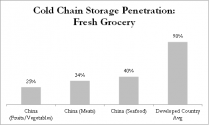His not wrong though, and while there are definitely aspects of North American rail network to learn, you can't take your cake and eat it. Aside from being an end user in the "white goods/container cargo" category, I am far from a SME in that category of transport so I won't comment much. That being said, package delivery in China is far faster and cheaper than in the US lol

If I am going to assume, with China being a manufacturing power house vs US being a consuming power house, its different game sending trucks from factory floors to a rail interchange then to a port for export or other domestic destinations for consumption vs taking goods from a port, directly onto rail and then onto distribution centers for trucks to destinations for consumption. The Chinese model, the producers are already scattered all around with the consumers, most likely in shorter than 500km circles so the trucks are going to have way more advantage than trains where as in the US model, the goods are gonna be concentrated in places like LA then shipped across the country. This is shooting off the hips using my logic so I may be wrong.
In the bulks, that is something I dabble with in both countries so I will comment. The situation is far more complex than the guy makes it out to be and its not really the fault of the Chinese rail system. Things like coal, in the US or Australia, goes straight from the mine via rail to either the port for export or powerplants that have long term contracts. You don't have that in China. Most of the power plants and steel mill contracts are bid on the market, so you never know who your end user will be. It works for places like Inner Mongolia or Xinjiang to train the coal out, but places like Shanxi and Shaanxi where most of the mines are little ones it don't make much sense. Of course its nice to run the train through and car dumper and be done with it lol. If you want to go intermodal, how are you going to switch between the rail carts and trucks and vice versa without the infrastructure built? Who is going to pay the difference for the losses in transport, and change in quality? (keep in mind the sampling is done at the end point). Going from port to end user via train is great though, since the stockpile is there and we blend it there too, but its going to be low ton-km since its usually not that far from the end user.
Its also all very good making lots of profits, but that is easy if you don't sink in the funds to upgrade or adequately maintain the lines. Especially when you spend it on stock buy back instead lol. I've seen plenty of work for roads and highway upgrades, but not very many railway maintenance work. For context, I think the US rail maintenance market is around $7 or 8 billion a year. China spends 700 billion RMB a year, though that includes capital expenditures for new lines, of which there are few in the US. Kind of says the state of affairs of where the priority is lying lol, and why so many derailments across the country is expected. I am old school and I believe these infrastructures are the lifeblood of a country and should not be measured in profit like other industries.
End of the day, my view is, the hard rail infrastructure in China is way ahead of the US, let alone third world places like India. Electrifying most of the grid will minimize the dependence of imported diesel, and if EV trucks are a thing in the future, they would continue to compete with each other making a positive impact to the economy. There is plenty to improve upon especially in the service and marketing side based on the learnings from the US system, but those learnings also have to be adapted to the completely different economies that it is servicing.

